* 1735:Raising in Strasbourg of the future hussars of Chamborant
* 1756-1763:Seven Years' War, the regiment's colonel is the Marquis de Chamborant, who gives it its name
* 1791:Renamed 2nd Hussar Regiment
By tradition, the first 4 hussar regiments are named with the old term "Houzard", in memory of the first Hungarian huzard squadrons. The traditional name of the 2nd Hussars is "Chamborant Houzards".
-
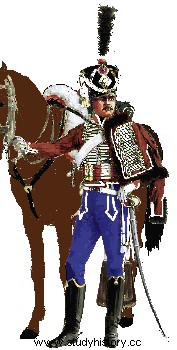
- 02nd Hussar
Colonels/Brigade Commander
Old regime
-
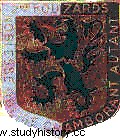
- Shield of the 02nd Hussar
descendant of a regiment of Houzards raised by Count Esterhazy in 1734 with Hungarian volunteers. In 1761 the Marquis de Chamborant gave it his name and colors:brown and blue. Became 2nd Rgt of Hussars, he participated in all the campaigns of the empire and inscribed on his standard the names of Austerlitz 1805 and Friedland 1807. Installed in Sourdun in 1979 he became the armored reconnaissance Rgt of the 3rd Army Corps .
-
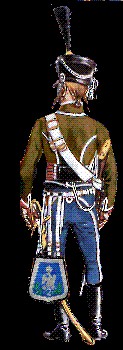
- 02nd Hussar
The 2nd regiment of hussars (2nd RH) is a regiment formed in 1735. It distinguished itself during the revolutionary and Napoleonic wars in particular (battles carried on the standard) at Valmy (1792), Austerlitz (1805), Friedland (1807), l'Isly (1844), Solférino (1859), Flandres (1914) and on the Avre (1918)
It is currently the Armored Intelligence Research Regiment of the Army.
Creation and different denominations
* 1756-1763...:Marquis de Chamborant, owner of the regiment that bears his name
Revolution and Empire[edit]
* 1792-1793:Count Charles Louis Joseph de Gau de Fregeville - brigade leader (**)
* 1793-1806:baron Jean-François Thérèse Barbier - brigade leader then colonel(*)
* 1806-1809:baron François-Joseph Gérard - colonel (**)
* 1809-1813:baron Gilbert-Julian Vinot - colonel (*)
* 1813-1815:baron Alexetre-Louis de Séganville - colonel
* 1815-1821:prince Joseph-Marie de Savoie-Carignan - colonel
(*) officers who later became brigadier general.
(**) officers who later became major general.
Colonels killed or wounded while commanding the regiment during this period:
* Head of Brigade Barbier:wounded on December 2, 1805
* Colonel Gérard:wounded on November 3, 1806
* Colonel Vinot:wounded in 1808
Officers wounded or killed while serving with the 2nd Hussars between 1808 and 1815:
-
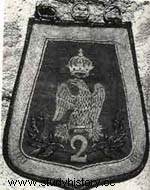
- Sabretache
* Officers killed:7
* Officers died of their wounds:5
* Officers injured:59
Restoration
* 1821-1830:Viscount Gauthier de Rigny
* 1830-1843:Count Duroc de Chabanne
* 1843-1848:Gagnon
2nd Republic and Second Empire
* 1848-1855:Dumor
* 1855-1862:l'Huillier
* 1862-1868:Gadic
* 1868- 1873:Plaice
1870 - 1914
* 1868-1873:Carrelet
* 1873-1875:Aubert
* 1875-1882:de Bonne
* 1882-1887 :Roustan
* 1887-1894:from Bellegarde
* 1894-1898:from Chalendar
* 1898-1904:from Men
* 1904-1908:Gouget de Landres
* 1908-1914:Carles de Carbonnières
First World War
* 1908-1914:Carles de Carbonnières
* 1914-1917:Gouzil
Between two wars
* 1919-1920:Boullaire
* 1920-1921:Huet
* 1921-1923:Pichon-Vendeuil
* 1923- 1930:Pumpkin from Boisfleury
* 1930-1932:Cyr de Lafon
* 1932-1934:Testard
* 1934-1936 :Bridoux
* 1936-1939:Dodard des Loges
* 1939:Abrial
World War II
* 1940-1941:Bois de la Calande
* 1941-1942:Boutaut de Lavilléon
* 1942:Désazard de Montgaillard (*)
(*) When the Free Zone was invaded, Colonel de Montgaillard refused to lay down his arms and ordered his regiment to continue the fight in North Africa or within the Resistance.
From 1945 to the present day[edit]
* 1944:Darizcuren
* 1945:Roy
* 1945:O'Neill
* 1946:Séguineau de Préval
* 1946-1951:Salesse-Lavergne
* 1951-1953:Gentien
* 1953-1955:Laurent
* 1955-1956:de Charbot
* 1956-1960:Bernard
* 1960-1961:Moreau
* 1961-1962:Champeaux de la Boulaye
* 1962-1964:Mery (*)
* 1964-1965:Douat
* 1965-1967:de Vanssay
* 1967-1969:Menard
* 1969-1971:Mazin
* 1971- 1973:de Bermondet de Cromières
* 1973-1975:Maisonnet
* 1975-1977:Dupuy de la Grand'Rive (**)
* 1977-1979 :Zwingelstein (***)
* 1979-19 81:Rimaud
* 1981-1983:Dumouchel de Prémare
* 1983-1985:Böy
* 1985-1987:Barrois
* 1987-1990:d'Harcourt
* 1990-1991:Bart
* 1991-1993:Millet
* 1993-1995:Martin
* 1995-1997:Michel
* 1997-1999:Ballarin
* 1999-2001:Lépinette
* 2001-2003:Nicolazo de Barmon
* 2003-2005:Lacoste de Fontenilles
* 2005:Fox
(*) Future Chief of Staff of the Army (**) Future Inspector of Armored Cavalry (***) Future Commander of the 1st Army
Revolution and Empire
* 1792:Grisvelle, Verton, La Croix-aux-Bois, Grand-Pré, Montcheutin, Valmy (*) and Jemmapes
* 1793:La Roche, Hondschoote, Letrecies, Wissembourg and Edelsheim
* August 5, 1794:2 squadrons are part of the Desgranges brigade within the Schaal division of the Army of the Rhine.
* 1794:Marolles, Fleurus, Mons , Eterhoven
* 1795:Holland campaign under Pichegru, Schwalbach and Kreutznach, Capture of the Dutch fleet at Texel
* 1796:Burg Eberach
* 1797:Crossing the Rhine at Neuwied
* 1799:Mannheim, Engen and Hirchberg
* 1800:Dillerich, Bopfingen, Kelheim and Germersheim
* 1803:Nienberg
* 1805:Austerlitz (*)
* 1806:Halle, Crewitz and Mohrungen
* 1807:Osterode and Friedland (*)
* 1809:Medellin and Alcabon
* 1810:Ronda and Sierra de Cazala
* 1811:La Gerboa, Los Santos and Albufera
* 1812:Somanis
* 1813:Leipzig
* 1814:Montereau
* 1815:defense of Belfort
battle brought to the regimental flag.
From 1815 to 1848
The regiment took part in the African campaigns against Abd El-Kader and received the nickname "Lions of the Desert".
* 1844:Battle of Isly (*)
* 1845:Sidi Brahim where the 2nd squadron of the regiment is almost annihilated alongside the chasseurs à pied of the 8th battalion.
Second Empire
* June 14, 1859:Battle of Solférino (*):He faced the Austrian hussars there, and distinguished himself in a charge near the Casa Nova farm, high place of the battle.
* 1870:he participated in the battles of Rezonville, Gravelotte and Metz.
First World War
* 1914:Flanders
* 1918:Avre
From 1945 to the present day
* Until 1979:Garrison in Orléans
* Since 1981:Garrison in Sourdun
The 2nd Hussars, since receiving its new in-depth intelligence mission in 1997, carried out a profound and rapid transformation under the impetus of Colonel Ballarin then under the orders of Colonels Lépinette, de Barmon, de Fontenille and Renard . He very quickly acquired recognized skills and found himself engaged, in particular, in Yugoslavia, Côte d'Ivoire and Afghanistan.
Currency
“Noblesse oblige, Chamborant as much”
This is the motto of the Chamborant family.
Regiment decorations
The regiment of "brown hussars" or "hussars of Chamborant" wears the gold medal of the city of Milan in memory of its participation in the campaign of 1859 (Solférino). Squadrons were cited in WW1, but not the whole regiment. Like most light cavalry regiments, it is poorly decorated for two reasons:
* the current system of fodder only concerns the 20th century
* after the war of 1870, the cavalry was most often engaged squadron by squadron:it was they who received decorations and not the regiment as a whole.
Today
The 2nd Hussars is an atypical case in the French army; it offers a rare example of a radical change of profession, (like its predecessor, the 13th RDP in 1963).
At the request of the Chief of the Army Staff, in 1996, who wanted to increase French capability in the field of anticipatory intelligence, he undertook a complete change of mission, while relying on the spirit of audacity and freedom of thought inherited from the tradition of the hussars.
In less than 5 years, it has acquired the capacity to carry out cutting-edge missions, in a context of increasing power, within NATO, of "Special operations Warfare".
Missions
This unit's mission is to seek intelligence in the depths of the enemy system or crisis zones. These actions are carried out by small teams (patrols) of 6 men acting in complete autonomy on the rear of the enemy. Infiltration towards the objective can be done by LAV, by helicopter or by any other means adapted to the conflict or crisis zone. Under no circumstances are means of transport (land or air) used to reach the objective:the final phase of the approach is only done on foot for reasons of discretion.
Unlike conventional units, patrols do not communicate with each other and do not constitute a tactical device. Each receives a specific target that it approaches by stealthily infiltrating a distance of around 80 to 150 km. It then sends the fruit of its observations, in an encrypted way, to a center which analyzes the information and transmits it to the command of the theater of operations, which it allows to direct its action and to anticipate:we speak of intelligence of anticipation).
Many patrols have the ability to guide aircraft to the observed objective, either by direct designation or by radio vectoring.
The 2nd Hussar Regiment has distinguished itself for several years by its capacity for innovation and "tailor-made" implementation of new intelligence methods adapted to the needs of the employer (commander of the theater of operations). For its effectiveness in crisis areas, it has also been noticed by high NATO authorities, and has been designated as a Eurocorps deep search unit.
Membership[edit]
The 2nd Hussars is made up of 850 soldiers divided into 6 squadrons:
* 4 intelligence collection squadrons each comprising 11 armored search patrols and 2 to 4 specialized patrols (nautical patrols, motorcycle, security, specialized intelligence)
* 1 command and logistics squadron
* 1 administration and support squadron
* 1 reserve squadron.
Equipment[edit]
It is mainly made up of 3.5t amphibious light armored vehicles (VBL).
The patrols are equipped with ultra-modern means of shooting, night observation and long-distance encrypted transmission, by radio or satellite.
The men have camouflage uniforms and equipment (special bags, straps) suitable for carrying very heavy loads during infiltration on foot.
Uniform
The regiment's traditional uniform consists of a brown fur coat, a brown dolman and azure breeches. When Louis XVI decided that cavalry regiments would be identified by a color, Queen Marie-Antoinette mischievously proposed to the Marquis de Chamborant that her hussars (soldiers reputed to be turbulent and arrogant) wear the color of the Capuchin monks' bure (brown). The Marquis, stung, replied:"The King will see my monks at work". Several years later, when a second color became necessary to distinguish the regiments, Marie-Antoinette asked Chamborant which second color he would choose. Chamborant replied "if it pleases my queen, I will choose the color of her eyes". Thus Chamborant Houzards now wore brown and azure.
-
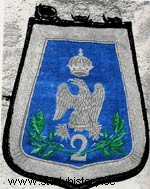
- Sabretache
